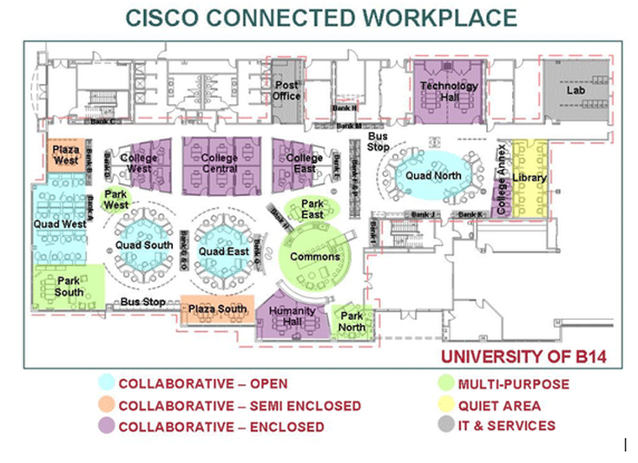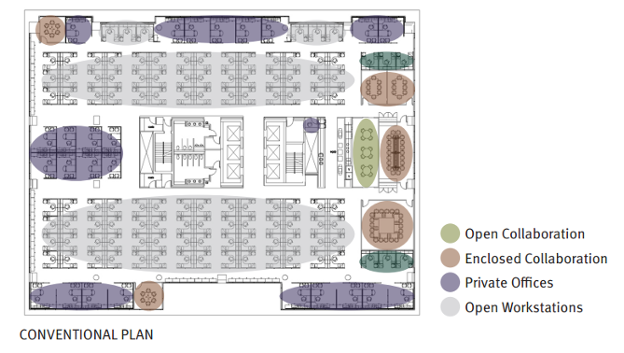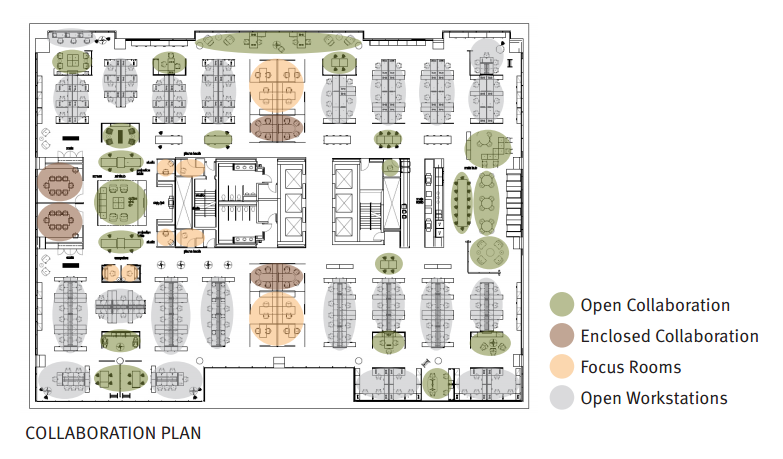Workspace usage trends are changing rapidly. People no longer come to a building from 9-5 and lock themselves in a single office. Technology has empowered people to be much more mobile, yet are buildings are somewhat slow to catch up. Coworking and Collaborative Workspace Design are crucial to today’s organizations.
I’ve written an entire series on the shift towards collaboration. Much of that writing deals with what Gensler refers to as the 4 work modes. I come back to this topic over and over because it’s of such profound importance. My role in design centers around technology, but my personal viewpoint is that technology is useless if it doesn’t solve problems. For this reason, I tend to take a very holistic approach. This often means that I’m focused more on facilitating communication and achieving objectives, rather than moving straight to the fancy gadgets. In this article, we’ll briefly review and highlight studies by Cisco and Herman Miller.
Realizing this trends noted above, the Cisco Workplaces Resources group (WPR) in charge of real estate did some research and discovered that while lack of meeting space was a consistent issue, offices and cubicles and offices were vacant 65% of the time. Following this discovery, they set out to fix the problem. The effectiveness of this effort has resulted in significant savings, illustrated in the chart below, which was taken from the actual Cisco case study. For the full study, follow the link to the resources at the end of this article.
Table 1. Cost Savings from the Shared Workspace
Cost Category Percent Savings
Real estate rent:Accommodating more people in the same amount of space 37%
Construction:Building a smaller space than typically required for 140 employees 42%
Workplace services: Reducing utilities and maintenance costs, and nearly eliminating the costs of moves, adds, and changes for workspaces through the use of flexible furniture settings 37%
Furniture: Purchasing less (and slightly less expensive) furniture than typically used in cubicles 50%
IT capital spend: Spending less on switches and switch ports 40%
Cabling:Reducing the number of wired IP cables required per workspace 60%
Equipment room space: Racking fewer switches because of wireless infrastructure 50%
Although these savings are dramatic, they all stemmed from just three key focal areas identified by the Cisco WPR group:
– Encourage collaboration through the use of technology
– Reduce real estate costs by leveraging technology to eliminate assigned seating
– Reduce infrastructure costs by leveraging wireless technology
This particular project occurred roughly a decade ago. At the time, you might be thinking that you couldn’t do this in most organizations, as employees would resent loss of their “personal” space. These needs were accommodated in other ways and the effectiveness measured by a team of specialists in architecture, design, psychology, and even cultural anthropology and sociology. Although it may have strayed from the mainstream, this makes solid business sense. As Mark Golan, VP of Worldwide Real Estate and Workplace Resources, puts it, “Nobody would consider building a manufacturing facility that they intended to use just one-third of the time. And yet that’s what we routinely do with work space. “
The concept, referred to as the Cisco Connected Workspace was designed around the concept of a university, with “quads” (big open spaces), informal meeting “plazas”, and break rooms. They also created enclosed offices called “colleges”, as shown in the sketch below:

Maybe the most impressive part of this tale is that it is not a cutting edge, new concept. This project was undertaken by Cisco over a decade ago.
There are numerous takes on this philosophy. The layouts below from Herman Miller, show two variations on an office plan. The first is a typical arrangement. The second is designed to support shared workspace and increased collaboration. First let’s start with the conventional floorplan copied and pasted right out of a 1990’s template:

Here is a breakdown of the space metrics, as cited in their study (see below for link to the full study):
• Square feet 24,150
• Occupancy 135
• Open collaboration 1
• Enclosed Collaboration 6
• Private offices 25
• Open workstations 110
• Space ratio 1 group/community:19 persons
• Square footage ratio 19% group/community:81% individual
By comparison, below is an identical square footage plan, based around the collaboration ideal:

Here are how those same metrics look in this version of the space:
• Square feet 24,150
• Occupancy 336*
• Open collaboration 30
• Enclosed collaboration 6
• Open workstations 144
• Focus rooms 15
• Space ratio 1 group/community:7.3 persons
• Square footage ratio 40% group/community:60% individual
The floorplan above utilizes fewer and smaller workstations, offsetting this reduction by providing three times as much collaboration space. With workspace trends showing office utilization anywhere between 50-75% unoccupied, this definitely rates as data driven space planning. Notice how the collaboration area lines the egress to stimulate impromptu interaction. Similarly, there is lounge area available outside of the formal meeting space to encourage informal interaction before and afterwards.
The location and distribution of collaboration spaces is of vital importance. Several collaborative workplace designs have failed because the collaborative spaces were not utilized. While this may have something to do with culture, there are many identifiable instances related to architecture. For instance, when facilities cluster the collaboration areas together away from the focus areas, utilization tends to suffer dramatically.
Arguably, the two most influential trends pushing the collaborative workplace movement are Workplace Mobility and the Millennial Factor. If you’re not absolutely clear on the impact of these two factors, be sure to read our article on these topics here. It includes some very surprising statistics.
Be sure to sign up for our blog for more insightful articles on workplace design. We only publish insightful, useful, information that is written in a format for busy professionals.
Resources:

